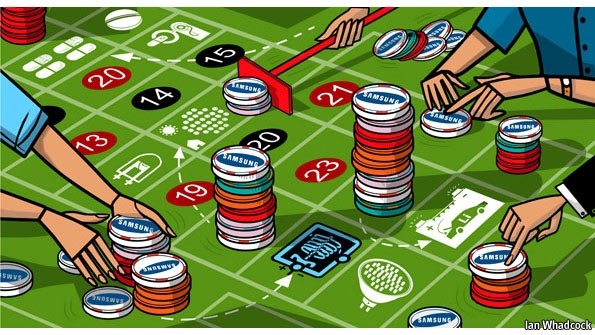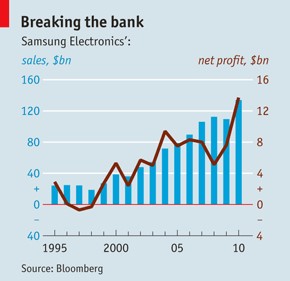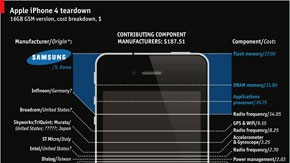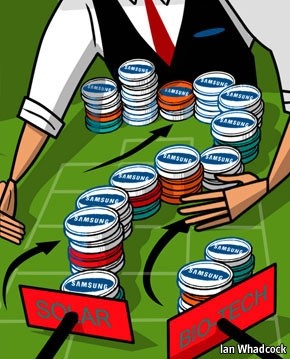

 字體:小 中 大
字體:小 中 大 |
|
|
|
| 2018/03/05 15:08:06瀏覽17|回應0|推薦0 | |
SamsungThe next big betThe world’s biggest information-technology firm is diving into green technology and the health business. It should take care; its rivals should take noticeOct 1st 2011 | SEOUL | from the print edition
IN 2000 Samsung started making batteries for digital gadgets. Ten years later it sold more of them than any other company in the world. In 2001 it threw resources into flat-panel televisions. Within four years it was the market leader. In 2002 the firm bet heavily on “flash” memory. The technology it delivered made the iPhone and iPad a reality, and made Samsung Apple’s biggest supplier—and now its biggest hardware competitor.
Related topics · Samsung The handsome payoffs from these ballsy bets made the South Korean company a colossus; last year its sales passed $135 billion. Now it is embarking on a similarly audacious plan to move away from electronics into technologies where it barely has a presence today. It intends to spend $20 billion over ten years on solar panels, light-emitting diodes (LEDs) used for lighting, electric-vehicle batteries, medical devices and biotech drugs. These businesses shift Samsung away from easily substitutable gadgets towards more essential industrial goods (see table)—or from “infotainment” to “lifecare”, as the company puts it. Just as electronics defined swathes of the 20th century, the company believes green technology and health care will be central to the 21st. With these plans Samsung sees itself bringing technologies that are vital for society into much broader use. The company has always had an eye for more than just the bottom line, seeking both to epitomise and to further the progress of its home country. Now it talks idealistically of improving the world by driving down the costs of zero-carbon power and providing poor countries and rural areas with medical equipment and drugs that they cannot afford today. But the plans are also an ambitious industrial power play, one that challenges some of the world’s biggest companies. Success would raise Samsung to new heights. Failure could lead to the firm losing what it already has, no longer able to flourish just as a maker of commodity gadgets and components. The 83 firms that are tied together in Samsung’s remarkably complex structure provide 13% of South Korea’s gross exports. Samsung Electronics, the biggest of them, started making transistor radios in 1969, and has since evolved into the world’s leading manufacturer of televisions and much else. It is on track to unseat Nokia as the biggest maker of mobile phones by volume next year. Interbrand, a consultancy which seeks to calculate brand value, puts it in the world’s top 20, ahead of Sony and Nike. It has come second only to IBM in the number of patents earned in America for five years running. Yet Samsung wants to diversify away from consumer electronics, a market that suffers from falling prices, thin margins, fast product cycles and fickle customers. Chinese rivals may do to Samsung what Samsung did to Western and Japanese firms in the past. “The majority of our products today will be gone in ten years,” Samsung’s patriarch and chairman, Lee Kun-hee, told executives in deliberately alarmist tones last January. To survive, he said, the company must not only go into the new businesses it has identified, but open itself up to work with partners and even make acquisitions. Samsung has long been a closed world from that point of view, a disposition reinforced after the disastrous acquisition of a PC maker in the 1990s. But now the company knows it needs new skills, sales channels and customers. Doing it the Samsung way By 2020 Samsung’s Mr Lee wants the five new business areas to provide $50 billion of revenue, and Samsung Electronics to be a $400 billion company (for all his provocations to his staff, there are still going to be a lot of flat screens and memory sold). It is a brash goal, admits Inkuk Hahn of Samsung’s strategy team. But ten years ago people were incredulous when Mr Lee insisted that Samsung, which then had sales of $23 billion, could be the number-one technology company, with sales of $100 billion. It claimed that crown just eight years later. “This is why you have to believe us,” Mr Hahn insists. The new businesses look remarkably disparate, but they share a need for big capital investments and the capacity to scale manufacture up very quickly, talents the company has exploited methodically in the past. Samsung’s successes come from spotting areas that are small but growing fast. Ideally the area should also be capital-intensive, making it harder for rivals to keep up. Samsung tiptoes into the technology to get familiar with it, then waits for its moment. It was when liquid-crystal displays grew to 40 inches in 2001 that Samsung took the dive and turned them into televisions. In flash memory, Samsung piled in when new technology made it possible to put a whole gigabyte on a chip. When it pounces, the company floods the sector with cash. Moving into very high volume production as fast as possible not only gives it a price advantage over established firms, but also makes it a key customer for equipment makers. Those relationships help it stay on the leading edge from then on. The strategy is shrewd. By buying technology rather than building it, Samsung assumes execution risk not innovation risk. It wins as a “fast follower”, slipstreaming in the wake of pioneers at a much larger scale of production. The heavy investment has in the past played to its ability to tap cheap financing from a banking sector that is friendly to big companies, thanks to implicit government guarantees much complained about by rivals elsewhere. From crisis to crisis Competitors also balk at the way that Samsung scales up quickly to supply parts to other firms as well as to price its own gadgets keenly. Supplying the rest of industry drives down Samsung’s costs yet further, with its rivals in effect financing its success. This strategy can create problems. Samsung is Apple’s most important supplier in the smartphone and tablet-computer markets. Samsung components, which include all the product’s application processors, account for 16% of the value of an iPhone. It is also Apple’s greatest competitor in those markets. Apple is now suing the socks off the company for copying the look and feel of its products. At the same time it is urgently seeking new ways to diversify its supply chain.
Many companies saw the potential of technologies such as liquid-crystal panels, flash memory and rechargeable batteries. But few could or would invest billions in a single shot. That Samsung could is in large part due to a cult of personality around Mr Lee, who likes to keep things shaken up. “Change everything but your wife and children,” he exhorted managers in 1993. Three years later he lit a bonfire of 150,000 gadgets because some were defective. Other bosses often need to face a crisis—a “burning platform”, in the memorable phrase of Stephen Elop, Nokia’s boss—before they make changes. Samsung does so when things are going well. The company has pushed out older managers and restructured its divisions over the past two years despite posting record profits even in the global financial crisis. Management by perpetual crisis is perhaps a reflection of the company’s national roots. In 1960, when the Samsung companies were taking off, South Korea, battered by recent war, had a GDP the same size as Sudan’s; its last dictatorship fell only two years before the Berlin Wall. Today, though it enjoys one of the world’s highest living standards, South Korea is still an emerging market in some ways, with endemic corruption and some economic structures that border on the feudal.
Find out how much of an Apple iPhone is actually a Samsung with our "teardown" infographic Samsung, like its host country, has a foot in both the industrialised and developing worlds, which it has used to its advantage. While it has always produced things for major IT firms and Western consumers, it has aimed products at poor countries, too. This not only gave Samsung scale, but also market shares in the world’s fastest-growing economies. Whereas Western firms reeled in the recent recession, Samsung flourished, buoyed by sales in markets that never stopped growing. From laptop to rooftop Some of the five new businesses Samsung has set its sights on are not that far from what the company does already. Its experience in semiconductors and flat-screen televisions fits easily with solar cells and LED lighting: the technology, materials and production processes are similar. Likewise, its expertise in batteries for gadgets smooths the way for making car-sized ones. The firm wants to apply the magic of ever cheaper chips to medical devices as it did mobile phones. Even drugs aren’t so far afield when one sees them in business-process terms: high-volume manufacturing with low defect rates. In all these fields Samsung believes it can sit—rather as Korea does geographically—in between China, with its cheap products, and Japan, with its costly, high-quality ones. In solar energy Samsung plans to make panels for both domestic and industrial use. Producing panels for “utility-scale” projects may allow it to lower prices for the residential market. Changsik Choi, who heads the business, also speaks optimistically of a “brand halo effect”: consumers whose living rooms are stuffed with Samsung products may choose the company for their rooftops too. Samsung’s dominance of the television market has already made it the world’s second-largest maker of LED components (Japan’s Nichia is the first). Since they consume a fraction of the power of conventional light bulbs, last longer and avoid some of the drawbacks of compact fluorescents, the first-generation alternative, LEDs are expected eventually to become the norm for all sorts of lighting; the market is growing by 65% a year. Samsung already sells LED lighting in South Korea and plans soon to expand abroad. In this market it will hew to its strategy of supplying parts to others, thereby lowering costs for its own products. In electric-vehicle batteries Samsung has joined forces with Bosch, the world’s biggest supplier of car parts and a fount of expertise on power- and engine-management. Samsung sees their partnership, SB LiMotive, as crucial since the car business relies on close ties between carmakers and their suppliers. Some carmakers, like Nissan and Toyota, will continue developing their own batteries, but Samsung thinks that many carmakers will not want to be in the battery business, just as they are not in the petrol business, and that they will be a rich source of demand. Chrysler and BMW are among SB LiMotive’s first customers. For medical devices Samsung aims to use information technology to lower costs, add features and make devices accessible to more people, particularly the poor. For example, it is developing X-ray machines that expose patients to less radiation and do away with physical film. Last year Samsung began selling a machine for testing patients’ blood chemistry that is smaller, cheaper, uses less power and offers more functions than rivals’ devices. In April it bought Medison, a South Korean maker of ultrasound equipment, as a way to get further into the market: it is looking at buying body-scanner firms too. In biotech drugs the company plans to begin as a contract manufacturer of biosimilars (generic versions of biotech drugs) and has partnered with Quintiles, a drug outsourcer. The strategy lets Samsung gain experience while assuming little commercial risk. It is building a factory outside Seoul and has already begun developing biosimilars for medicines with patents that expire in 2016. Incumbents and incomers The markets are certainly promising, but they entail huge risks. Nor is the size of Samsung’s commitment quite on a par with the overwhelming force it has deployed in the past. The solar and LED businesses already struggle with oversupply, meaning Samsung may get walloped by the same dramatic price erosion as it has seen in liquid-crystal flat panels. Electric-vehicle batteries may be in similar straits if demand for the cars they might power remains sluggish. They are also in the crosshairs of Chinese companies, as are medical devices and drugs. In a bid to escape the vagaries of consumer electronics, Samsung may be ploughing headlong into the areas most ripe for invasion by a new breed of emerging-market titans. Acquisitions, a way of life in the drug business, are also a challenge: knowing what to buy and when is a skill that Samsung has never developed. The same applies to dealing with government regulators: Samsung’s towering importance at home may give it a false confidence in its ability to handle governments elsewhere. Its position as a domestic titan could be a hindrance in other ways. Working with partners entails sharing information and a view of joint success that is at odds with its insular corporate culture. The international talent the company will need to attract is also less likely to be moved by the admonishments and appeals to national grandeur that Mr Lee has used to build Samsung’s success. They might, indeed, find such things wearisome.
Samsung’s rivals are ready for a fight. Philips and GE have been preparing to compete with firms in emerging markets for years, devising cheap products and building on existing relationships with clients. Toshiba plans to spend an extra $9 billion in the energy and environment sectors over the next three years on top of its normal capital expenditure, research and acquisitions. Fumio Ohtsubo, Panasonic’s boss, praises his Samsung rivals for their low prices but believes his company develops superior technology. “If we can get the same conditions in terms of free-trade agreements, low corporate taxes and other incentives, then we should be able to compete,” he says. In medical devices Samsung will be up against firms like Philips, Siemens, Toshiba, Hitachi and GE (for which Samsung made medical equipment between 1984 and 2004). GE’s Indian office famously reduced the cost of an electrocardiogram machine from $2,000 to $400. And the fact that hospitals prefer to buy different equipment from a single vendor so that, in principle, everything works together puts a maker of this-and-that at a disadvantage, even if it is cheap. Perhaps the biggest challenge, though, will be one of succession. The 69-year-old chairman’s son, Jay Y. Lee, 43, was named president last December. Educated in Japan (like his father and grandfather, the firm’s founder) and at Harvard Business School, he has been groomed from the start. His first test will be reforming the jumble of opaque, interlocking relationships and conflicts of interest that passes for Samsung’s corporate governance. The “Samsung group”, as it is often known, has no legal identity. The 83 firms sit under an umbrella company called Everland, in which the Lee family has a controlling 46% stake. The family also has minority positions in other Samsung firms, which often hold shares in other members of the group, and indeed in Everland. For example, the family and related interests own 21% of Samsung’s life-insurance firm, which owns 26% of its credit-card business, which in turn owns 26% of Everland. Get it? Nobody other than the Lees really does. The company must change if only to avoid South Korea’s devastating 50% inheritance tax after the elder Lee’s passing (his father died at the age of 77). That would further whittle the family’s stakes, notes Shaun Cochran of CLSA, a broker. He expects a holding company to be formed, so investors have clearer exposure to the different parts of Samsung’s businesses. The younger Lee will also need to root out corruption, which his father often complained about without rising above it; the elder Lee’s 2008 conviction for tax evasion was pardoned in 2009 on the ground of his importance to the country. When the dealing’s done Chairman Lee’s fear is that successful companies get flabby when they hit middle age. He saw that in Sony, founded in 1946, which has been struggling since the 1990s. Samsung Electronics turned 40 in 2009, which prompted Mr Lee to lay the groundwork for the five new growth areas. Diversification is essential. In the mid-1990s almost all of its profits came from DRAM memory chips: when the market soured in 1996, its profits shrivelled by 95%. Samsung may be swapping “infotainment” for “lifecare”—but it is still in the hardware business, and that may leave it more vulnerable than it thinks. Many of today’s computer and electronics giants are getting out of the manufacturing businesses altogether. IBM has shifted to services, trailed by Japan’s Fujitsu, while Philips and Siemens both sold their IT businesses to focus on other areas. But getting out of things is not something Samsung is good at. Despite a commitment to perpetual crisis, a mixture of implicitly subsidised capital, weak shareholder pressure and family control has allowed it to stick too long with dodgy decisions—such as its move into cars, brought short only by the Asian financial crisis, and its only-now-ended commitment to hard-drive manufacture. Even with a $20 billion bankroll, bets can be spread too thin. Perhaps the biggest risk for Samsung is not that none of its wagers will win, but that it won’t be able to stop betting on the ones that don’t. Knowing the right time to bet is a great gift. So is knowing the right time to walk away. from the print edition | Briefing The next big bet Sep 30th 2011, 16:49
It has been one and half year since Lee Kun-Hee returned to the seat of president. In 2010’s February, Samsung reported historic record-high sales for 2009 of about 136 trillion won becoming the largest maker of computer memory-chips as well as the threatened competitors against Nokia, Sony, LG and Apple. Samsung’s Lee Kun-Hee with his only son Lee Jae-Yong (Jay Y. Lee) has expanded her territory from transistor radio to the appliance such as refrigerator and washing machine and to the informative technology like laptop, printer and mobile-phone.
The most important either friend or enemy in Samsung’s growing history is Sony, as we can see in this book “Sony Vs Samsung: The Inside Story of the Electronics’ Giants Battle for Global Supremacy”. For two decades, Samsung’s rapid rise with Sony’s decline in the same product domain is famous for the compare of organizational processes and their executives’ political behavior. On one hand, Sony’s Wada Kovo and Howard Stringer is supported by some Japan’s politicians with the slogan “make. believe”; on the other hand, Samsung father-and-son team is supported by the major centralised government looking like a big holding company with effort, according to Mark Stocker. Clear, Sony becomes weaker and Toshiba, the most long-term highly-profitable conglomerate, is overtaken in the record of operating profits. On the last day in 2009, Lee Kun-Hee was pardened by South Korea’s President Lee Myung-Bak who was once the chief-executive of Hyundai. China’s Prime Minister Wen Jia-Bao also praised Samsung as the most foreigner responsible one and encouraged her to be a pioneer leader of China.
Samsung is good at the advance in hardware but sometimes attacked by other companies in the same circle. About half a year ago and not the first time, Taiwan Asus’ Shih Chong-Tang and Hon-Hai Guo Tai-Min (Terry Guo) criticized Samsung because of her possibilities of illegal copy. Also owning well-known technique in hardware, Asus and Hon-Hai drastically compete with Samsung very arduously, and walk along the similar direction. In fact, South Korea’s enterprises always suffer the resistance to Taiwan’s as soon as their product is put forward on the business table. The experience in marathon race of hardware mainly results in the biggest information-technology firm, letting her rivals around the world be busy searching money and human resource around the clock.
In comparison with hardware, there are still some shortage in software side. I bought a Samsung 512MB mp3 player of YP-T55 in 2005. This player is a good utility until now for its good-designed hard outlook, also with her advanced USB 2.0 better than most of brand’s. The interface is user-friendly when one plays the music along with switching the alteration such as the special turning device. The disc with this player containing a digital programme is not satisfied with me due to the strange design of language. After five years, I also purchased the 16GB micro-SD class 2 card for my HTC Legend mobile-phone. The micro-SD card, second to Toshiba’s, has the great appeal to me because of its inexpensive technology.
Samsung still has a long way to go in the future. Just like Taiwan’s Acer and HTC, Samsung who has become one of world’s top brand must use her advantages to overtake more world’s international consortium. The empire of Samsung is emerging as the challenge to Apple. The apparent example is the upcoming iPhone5 in a week. Now she has already surpassed most of Asian enterprises. May Samsung and the world be honour to walk forward.
Recommended 52 Report Permalink 這篇筆者算很成功的初次介紹三星的成長,雖然後來三星出了紕漏,判斷的依據是其他網友在之後一週的再次回文共鳴及筆者對這篇之後的韓國電子產品的銷量成長的確更快,雖然仍對其獨立研發能力打過問號。三星的消費性電子產品,就筆者而言,就是從2005年所購買Samsung YP-T55 MP3 播放器,一直很耐用,作為課業存儲資料及陪筆者娛樂休閒用,讀了幾年大學生活,直到2010年有點滲到水而且忘記拔電池而告終。後來還買了一片Samsung的韓國廠製造水貨Class 2的手機記憶卡來玩玩,覺得不會比Toshiba差,好像有「新韓帝國」這麼一回事。那附近的產品來說,和日本三洋(現被併入國際牌),夏普(現為鴻海集團旗下),及索尼與東芝或aiwa、山水牌稍小牌來說,三星會重視的是售後服務,這是繼當年日本從1970年代石油危機間趁美國企業因為原油漲價而帶來的成本上揚衝擊,因此大挖研發人員及買斷歐美的通路,以講究售後服務作史無前例的突破,此前美國的家電是得利於自1920年代期提供分期付款的措施而吸引客群。 這篇筆者記得的原因是看了一篇非凡新聞的報導,華碩的施崇棠和鴻海的郭台銘開記者會,痛斥韓國IT及科技製造商企業侵權及違反著作財產權,又得到政府保護傘,對於消費者作出沉痛呼籲,別被銷售手法蒙蔽。筆者聽了有曾經以價格合理與否來衡量,的確後來Android 4.0以後的三星機種明顯太貴,內裝軟硬體設備沒有太過突出,自己貼起金條來。相對而言索尼很惦斤兩,保守個幾年反而帶來今天的獲利回復。筆者當年偶然在書店逛得這本,「Sony Vs Samsung: The Inside Story of the Electronics’ Giants Battle for Global Supremacy」曾經記得一段三星派人向索尼公司交流。倒是覺得今日御殿山的索尼「倒是」應該回過頭來和三星學習不妥,果然三星管理部門黑幕幢幢,若說要學,應該是經營策略的比較,不恥下問於現今鴻海的夏普和韓國另一之勁旅樂金。
這週也是蘋果電腦iPhone5 問市,筆者不用蘋果的產品,一是成本利益考慮,要顧及筆者娛樂滿足需求,二是筆者很注意市場民主化及多元性,偏向冒險而有基本規範的Google陣營。不過筆者現在使用的是Nokia Lumia 830為主及LG Stylus 2(之前使用V10,雖然稍微ㄠ,但仍不死心有APP要用,繼續玩),(2018,08,05補充,在二手市場轉售此機後使用Panasonic Eluga C中)。
從這十年的亞洲家電業及科技業幾間版塊大致上變動,筆者在這個討論區有大概十來篇的參與,有以菊地義明的Illustrated Dictionary of Business Keywords 台灣培生中文版參考,這本是1990年代日本經濟的縮影。之後聊日本產業界,這七八年以來,筆者視東芝及索尼的經營為從明治維新及昭和昇平的兩種型態天朝上國基準來看亞洲企業經營,加上與中國、韓國的企業管理及追縱經營現況,比較的確很精準預測成功到一些這兩間及日韓的企業發展走勢,並可以側說中國大陸和台灣的產業興衰提示。
這篇語法大致沒有問題,也較行雲流水些了,這篇先漫談一些概念,以後會注意緊密度及不要有場面會禮貌話太多。 |
|
| ( 心情隨筆|心情日記 ) |














